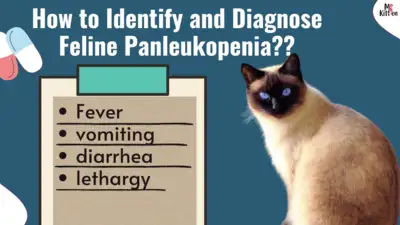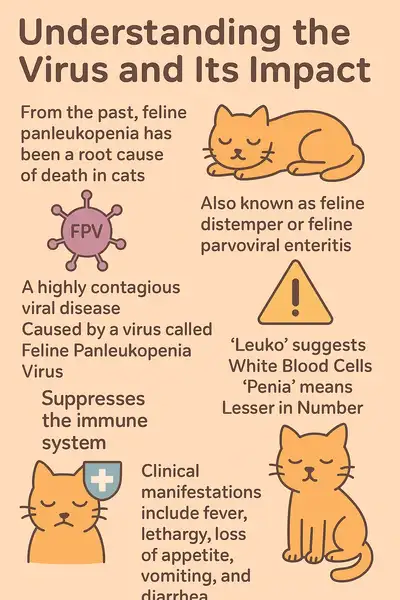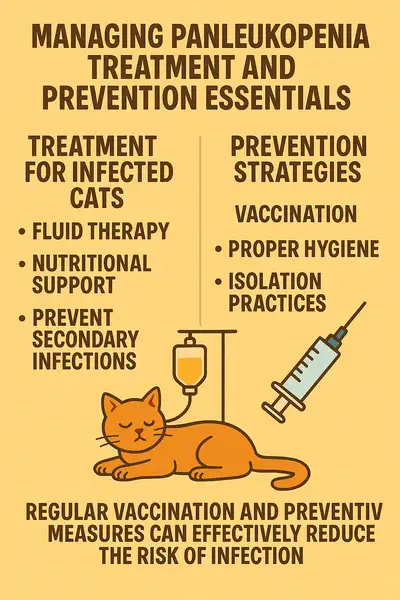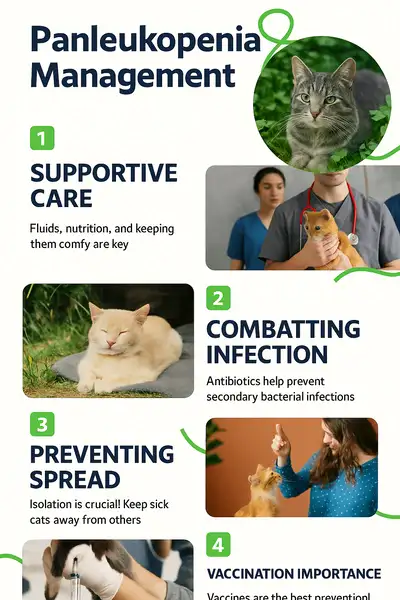Everything You Need to Know About Feline Panleukopenia
Panleukopenia may be invisible to the eye, but its impact is written on every pet parent’s heart.
Is your cat at risk of contracting a highly contagious and potentially life-threatening disease? Feline panleukopenia is a serious condition that affects cats worldwide, causing significant morbidity and mortality.
Feline panleukopenia, a viral disease, impacts the health of cats by suppressing their immune system, making them more susceptible to secondary infections. Understanding this condition is crucial for cat owners and enthusiasts to take preventive measures and provide appropriate care.
Feline panleukopenia is ruthless, but awareness is powerful.
What Is Cat Feline Panleukopenia and How Is It Transmitted?
Feline infectious enteritis, commonly referred to as feline panleukopenia, is a viral disease that poses a considerable risk to cat health. This condition is caused by the feline parvovirus, a highly resilient and contagious pathogen.
The feline panleukopenia virus (FPV) is a significant threat to the feline population, causing widespread illness and mortality, particularly among unvaccinated cats. Understanding the virus and its impact is crucial for cat owners and veterinarians alike.

Understanding the Virus and Its Impact
From the past, feline panleukopenia has been a root cause of death in cats. And currently, it is not as fashionable as other diseases due to the availability of effective vaccines.
The disease is also known as feline distemper or feline parvoviral enteritis, feline ataxia, etc. It is caused by a virus called Feline Panleukopenia Virus (FPV) a prototype of Feline parvovirus, is known as canine parvovirus and mink enteritis.
It is a highly contagious viral disease and has been proven fatal to the infected ones. In fact, it can continue living in the environment for more than you expect.
Feline Panleukopenia is a very resistant & tough disease, the word ‘Leuko’ suggests White Blood Cells and ‘Penia’ means Lesser in Number, mostly seen in the affected and infected animals.
Although viruses do not infect people, the virus infects and kills cells that are rapidly growing and dividing, such as those in the bone marrow, intestines, and the developing fetus.
Feline panleukopenia is characterized by its ability to suppress the immune system, making affected cats highly susceptible to secondary infections. The virus targets rapidly dividing cells, such as those found in the bone marrow, lymphoid tissues, and the gastrointestinal tract.
This results in a range of clinical manifestations, from mild to severe, including fever, lethargy, loss of appetite, and gastrointestinal symptoms like vomiting and diarrhea. The severity of the disease can vary depending on factors such as the age of the cat, its vaccination status, and overall health.

How Does Panleukopenia Spread Among Cats?
Feline panleukopenia is primarily spread through direct contact with an infected cat’s bodily secretions, such as feces, urine, and saliva. The virus can also be transmitted indirectly through contaminated environments, as FPV can survive for extended periods outside a host.
Cat owners can inadvertently spread the virus on their clothing, hands, or through contaminated food and water bowls. Understanding how panleukopenia is transmitted is key to preventing its spread.
The Panleukopenia Virus is said to spread through another feline body in many ways. Any feline can be infected through the shedding of the virus in bodily secretions such as urine and vomit, and in the stools.
Another mode of transmissions is either direct contact with an infected cat or flies and parasites. It is advisable to not keep your cat to closer proximity to an infected cat.

Which Cats Are Most Vulnerable to Infection?
Kittens and unvaccinated cats are most vulnerable to feline panleukopenia infection. Young cats, especially those under four months, are at higher risk due to their immature immune systems and potential lack of full vaccination.
Pregnant cats can also transmit the virus to their unborn kittens, further emphasizing the need for vaccination and proper prenatal care. Ensuring that cats are vaccinated against feline panleukopenia is a critical step in protecting them from this potentially life-threatening disease.
How to Identify and Diagnose Feline Panleukopenia
Early detection of feline panleukopenia can significantly improve outcomes for affected cats. Feline panleukopenia is a serious viral disease that affects cats worldwide, making accurate diagnosis crucial for effective treatment.
Typically the infection and exposure of the symptoms take 5-7 days but can be delayed as two weeks approximately.
• For the beginners, no obvious sign has been seen.
• Depression.
• Anorexia.
• Fever.
• Vomiting, Dehydration, Diarrhea.
• Lethargy and sleepiness.
• Sudden Death.

What Are the Common Signs and Symptoms?
Feline panleukopenia presents with a range of symptoms that can vary in severity. Recognizing these signs early is vital for prompt veterinary care.
Early Warning Signs to Watch For
Initial symptoms may include lethargy, loss of appetite, and fever. Cats may also exhibit vomiting and diarrhea, leading to dehydration.
Advanced Symptoms Requiring Immediate Care
As the disease progresses, cats may develop more severe symptoms, including severe dehydration, hypothermia, and a significant decrease in white blood cells, making them susceptible to secondary infections.

How to Distinguish from Similar Feline Diseases
Feline panleukopenia can be confused with other feline diseases that present similar symptoms, such as gastrointestinal foreign bodies or other viral infections. A thorough diagnostic process is essential to differentiate it from these conditions.
| Disease | Common Symptoms | Diagnostic Tests |
| Feline Panleukopenia | Fever, vomiting, diarrhea, lethargy | Blood tests, viral detection tests |
| Feline Gastrointestinal Foreign Body | Vomiting, lethargy, loss of appetite | Imaging studies (X-rays, ultrasound) |
| Other Viral Infections | Varies, but may include fever, lethargy | Viral isolation, PCR |
Veterinary Examination and Diagnosis Process
Diagnosing feline panleukopenia involves a comprehensive veterinary examination and specific laboratory tests.
Physical Assessment Procedures
A veterinarian will perform a physical examination, looking for signs such as dehydration, fever, and abdominal pain. The cat’s medical history and vaccination status will also be considered.
Confirmatory Laboratory Tests
Laboratory tests, including blood tests to check for a low white blood cell count and tests to detect the virus, are crucial for confirming the diagnosis.
For the primary diagnosis, never make any delay to bring your feline to us once you face any sign mentioned above.
Common laboratory tests include the Enzyme-Linked Immunofluorescent Antibody (ELISA) and complete blood count (CBC).
A complete blood count or blood smear for the details in Red blood, white blood cell, and platelet counts.
The results may vary but most accurate results are found in the first week of the infection.
Managing Panleukopenia: Treatment and Prevention Essentials
Effective management of feline panleukopenia involves a combination of treatment for infected cats and prevention strategies to reduce the risk of infection. Cats diagnosed with panleukopenia require supportive care, including fluid therapy and nutritional support, to manage symptoms and prevent secondary infections.
The treatment for feline panleukopenia focuses on alleviating symptoms and supporting the cat’s immune system as it fights the virus. Prevention of cat panleukopenia is crucial, with vaccination being a key component of cat health care. The panleukopenia vaccine for cats is highly effective in preventing the disease.
Regular vaccination, along with proper hygiene and isolation practices, can significantly reduce the incidence of panleukopenia in feline populations. By prioritizing cat health care and adopting preventive measures, cat owners can protect their pets from this potentially life-threatening disease.
Treatment and Prognosis
The recovery for the newborns and feline under 8 weeks olds are poor. But there is a pretty good chance of survival for the older cats if treated early.
• Firstly the dehydration is taken care of.
• Nutrients are provided.
• Prevention from secondary infection which is most commonly due to low WBC (white blood cell count)
• Antibiotics to prevent any bacterial infection.
• Followup is taken every 5 consecutive days.
• The feline is kept under observation for the next 6 months. (Because some recovered cats can shed the virus in their urine & stool for up to 6 weeks.)
Prevention of Panleukopenia
Most of the cats develop a certain kinds of immunity after surviving the infection which protects them from future infections.
At present, there are vaccines that offer the best protection from feline parvovirus infection. Vaccination plays a vital role in prevention for any feline, to protect them from the viruses in our environment.
You must never forget your kittens first vaccinations in their six and eight weeks of age with a follow-up vaccine in the 16 weeks of age.
Due to their stubby noses, they might respire pathogens which might affect their respiratory system. Normal cats have an extra defensive layer in their noses that help keep bacteria and other pathogens away, but Persians lack this defense. Provide booster vaccinations against cat flu.
Another common disease of Persians is Hypertrophic Cardiomyopathy (heart disease). This disease thickens the heart wall then impairs the heart’s ability to pump blood around the body.
Luckily, there are drugs such as diuretics and ACE inhibitors that can decrease the workload on the heart and increase longevity. But before any medication, look for any such symptoms and visit your vet.
Current studies show genetically inheritable kidney disease in Persian cats which can be easily detected by your vet with ultrasonography.
Common symptoms of kidney disease are:
- Depression
- Frequent urination
- Weight loss
- Lack of appetite
- Drinking water excessively
Other than the mentioned diseases Persian cats have a higher incidence of the following conditions:
- Epiphora – Tears which run onto the face.
- Ringworm – Persians may be more predisposed to infection.
- Entropion – Turning in of the eyelid which can result in corneal ulcers.
- Malocclusion of the jaw.
- Myelodysplastic syndrome.
FAQ
What is feline panleukopenia, and how serious is it?
Feline panleukopenia, also known as feline distemper or feline parvovirus, is a highly contagious and potentially life threatening viral disease affecting cats. It is considered a serious condition due to its high mortality rate, especially among kittens and unvaccinated cats.
How is feline panleukopenia transmitted?
Feline panleukopenia is primarily transmitted through direct contact with an infected cat’s feces, urine, or other bodily fluids. The virus can also survive on surfaces and in environments for extended periods, making indirect transmission possible.
What are the symptoms of feline panleukopenia in cats?
Symptoms can range from mild to severe and include fever, lethargy, loss of appetite, vomiting, diarrhea, and dehydration. In severe cases, it can lead to a significant decrease in white blood cells, making the cat more susceptible to secondary infections.
How is feline panleukopenia diagnosed?
Diagnosis is typically made through a combination of physical examination, medical history, and laboratory tests such as PCR (Polymerase Chain Reaction) or ELISA (Enzyme-Linked Immunosorbent Assay) to detect the virus in the cat’s feces or blood.
What is the treatment for feline panleukopenia?
Treatment is mainly supportive, focusing on managing symptoms, preventing secondary infections, and providing intensive care, including fluid therapy and nutritional support. There is no specific antiviral medication for feline panleukopenia.
Can feline panleukopenia be prevented?
Yes, prevention is primarily through vaccination. Kittens should be vaccinated against feline panleukopenia as part of their core vaccinations, and booster shots are necessary to maintain immunity. Vaccination is highly effective in preventing the disease.
How effective is the panleukopenia vaccine for cats?
The panleukopenia vaccine is highly effective in preventing the disease. It is considered a core vaccine, meaning it is recommended for all cats regardless of their lifestyle or living conditions, due to the severity of the disease and its contagious nature.
What are the risks associated with the feline panleukopenia vaccine?
Like any vaccine, the feline panleukopenia vaccine can cause side effects, but they are generally mild and temporary, such as soreness at the injection site or mild fever. Serious side effects are rare.

